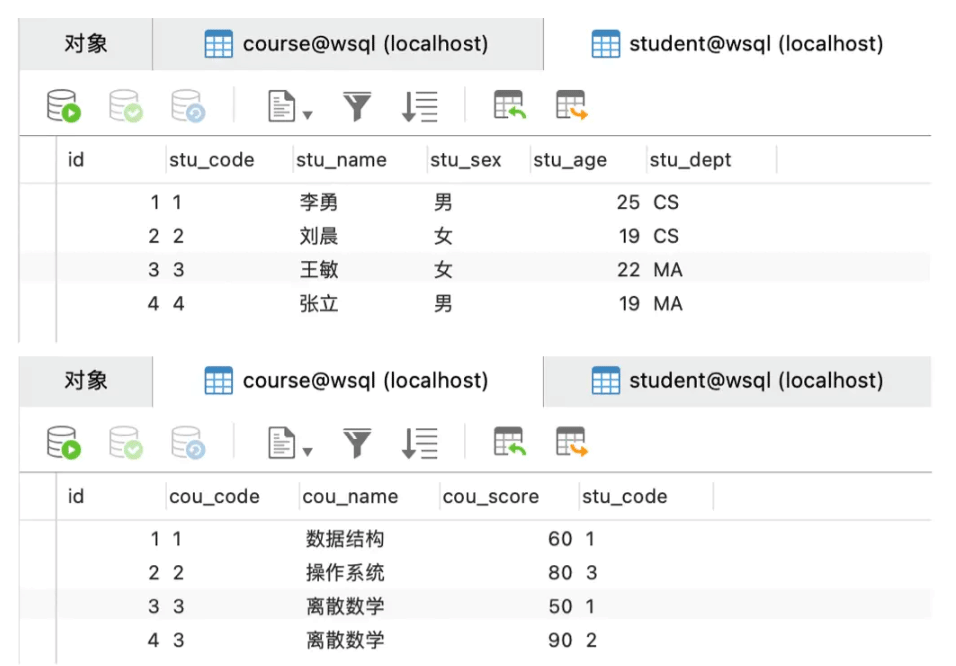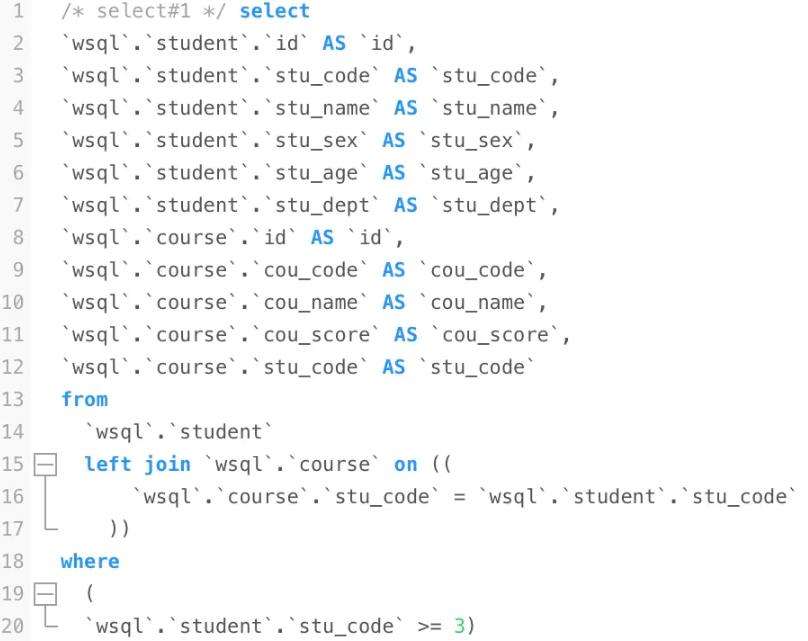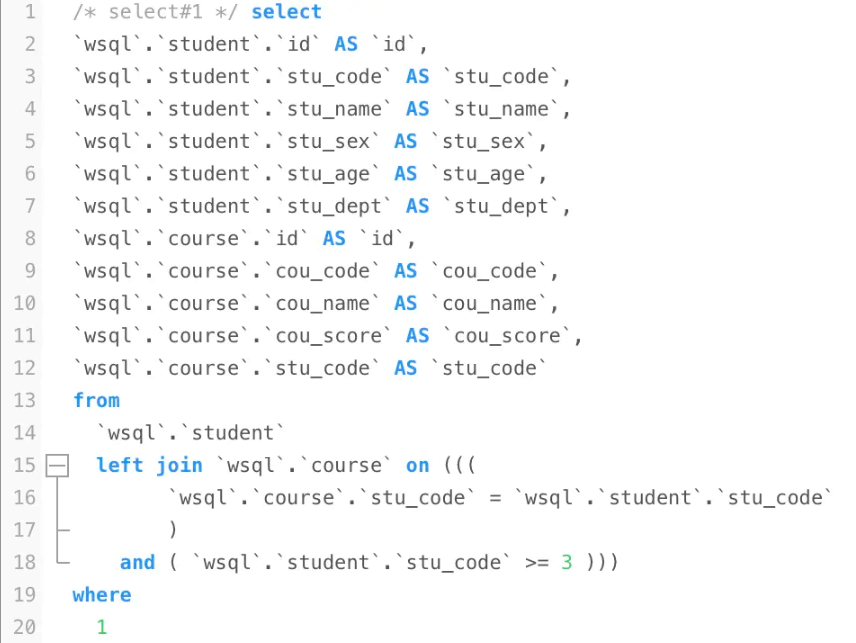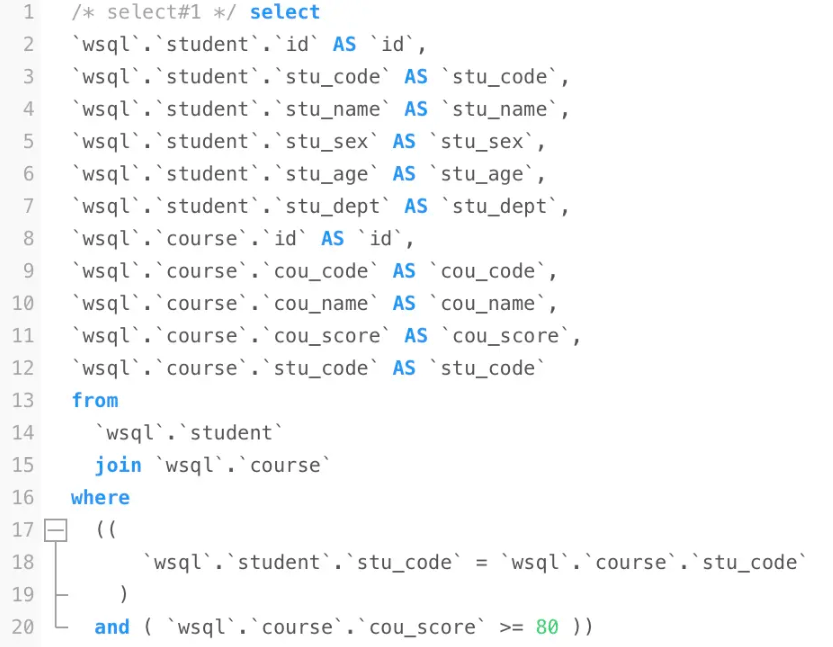What is the execution process of Mysql table connection?
1. Foreword
For connection operations, we put the association conditions between the driving table and the driven table after on. If additional conditions for the driving table and the driven table are added, If the filter conditions of the driven table are placed after on or where, no error will be reported, but the result set obtained is different? ? ?
1.1 The principle of mysql connection
As we all know, mysql is based on the Nested-Loop Join (Nested-Loop Join, not considering the optimization algorithm for the time being) algorithm to perform connection operations between tables The general process is as follows:
Select the driver table and use the filter conditions related to the driver table to execute a single-table query on the driver table;
For each record in the queried driver table, search for matching records in the driven table.
The pseudo code is as follows:
for each row in t1 { // 遍历满足对t1单表查询结果集中的每一条纪录
for each row in t2 { // 对于某条t1纪录,遍历满足对t2单表查询结果集中的每一条纪录
if row satisfies join conditions, send to client
}
}1.2 show warnings command
The sql statement we wrote is optimized by the optimizer It will then be handed over to the executor for execution, and the show warnings command can help us obtain the SQL optimized by the optimizer.
2. Preparation
The table structure is as follows:
CREATE TABLE `student` ( `id` bigint(20) NOT NULL AUTO_INCREMENT, `stu_code` varchar(20) NOT NULL DEFAULT '', `stu_name` varchar(30) NOT NULL DEFAULT '', `stu_sex` varchar(10) NOT NULL DEFAULT '', `stu_age` int(10) NOT NULL DEFAULT '0', `stu_dept` varchar(30) NOT NULL DEFAULT '', PRIMARY KEY (`id`) USING BTREE, UNIQUE KEY `uq_stu_code` (`stu_code`) ) ENGINE=InnoDB AUTO_INCREMENT=43 DEFAULT CHARSET=utf8mb4 CREATE TABLE `course` ( `id` bigint(20) NOT NULL AUTO_INCREMENT, `cou_code` varchar(20) NOT NULL DEFAULT '', `cou_name` varchar(50) NOT NULL DEFAULT '', `cou_score` int(10) NOT NULL DEFAULT '0', `stu_code` varchar(20) NOT NULL DEFAULT '', PRIMARY KEY (`id`) USING BTREE, KEY `idx_stu_code_cou_code` (`stu_code`,`cou_code`) ) ENGINE=InnoDB AUTO_INCREMENT=19 DEFAULT CHARSET=utf8mb4
The table data is as follows:

3. The difference between inner join inner join on and where
sql is as follows:
select * from student inner join course on student.stu_code = course.stu_code and student.stu_code >= 3 and course.cou_score >= 80;
Execute explain sql command:

Execute show warnings command:

Analysis: From the analysis of show warnings, For inner join connections, after optimization by the optimizer, the on connection conditions will be converted into where! In other words, where and on in inner connections are equivalent .
4. The difference between left join left join on and where
4.1 where driver table filter conditions
sql is as follows:
select * from student left join course on student.stu_code = course.stu_code where student.stu_code >= 3;
Execute explain sql command:

Execute show warnings command:

Result set:

Analysis: From the explain analysis, student is used as the driver table, and student.stu_code >= 3 is used as a filter condition to perform a full table scan, and then the student.stu_code (that is, in the on condition) of each queried record is used as a filter condition to perform a single table query on the driven table course.
4.2 on driver table filter conditions
sql is as follows:
select * from student left join course on student.stu_code = course.stu_code and student.stu_code >= 3;
Execute explain sql command:

Execute show warnings command:

## Result set:

Analysis: As can be seen from the explain analysis, student is used as the driver table to perform a full table scan, and then the student.stu_code and student.stu_code of each queried record are >= 3 (That is, in the on condition) are used as filter conditions to allow the driven table to perform single-table queries; At this time, student.stu_code >= 3 is not filtered for the driver table, and only takes effect when connecting to the driven table , the query cannot find matching records and returns NULL!
sql is as follows:
select * from student left join course on student.stu_code = course.stu_code and course.cou_score >= 80;
Execute explain sql command:

Execute show warnings command:

Analysis: As can be seen from the explain analysis, student is used as the driving table to perform a full table scan, and then the student.stu_code and course.cou_score of each queried record are >= 80 (that is, ) in the on condition are used as filtering conditions to allow the driven table to perform single-table queries;
4.4 where driven table filtering conditions
sql is as follows:

Execute the explain sql command:

Execute the show warnings command:

Result set:

From the analysis of show warnings? Left join connection becomes inner join connection?
Analysis: From the show warnings analysis, it can be seen that if the driven table has filter conditions in where, then the left join will be invalidated and optimized into an inner join connection. Therefore, the filter conditions of driven tables should be placed on instead of where.
The above is the detailed content of What is the execution process of Mysql table connection?. For more information, please follow other related articles on the PHP Chinese website!

Hot AI Tools

Undresser.AI Undress
AI-powered app for creating realistic nude photos

AI Clothes Remover
Online AI tool for removing clothes from photos.

Undress AI Tool
Undress images for free

Clothoff.io
AI clothes remover

AI Hentai Generator
Generate AI Hentai for free.

Hot Article

Hot Tools

Notepad++7.3.1
Easy-to-use and free code editor

SublimeText3 Chinese version
Chinese version, very easy to use

Zend Studio 13.0.1
Powerful PHP integrated development environment

Dreamweaver CS6
Visual web development tools

SublimeText3 Mac version
God-level code editing software (SublimeText3)

Hot Topics
 PHP's big data structure processing skills
May 08, 2024 am 10:24 AM
PHP's big data structure processing skills
May 08, 2024 am 10:24 AM
Big data structure processing skills: Chunking: Break down the data set and process it in chunks to reduce memory consumption. Generator: Generate data items one by one without loading the entire data set, suitable for unlimited data sets. Streaming: Read files or query results line by line, suitable for large files or remote data. External storage: For very large data sets, store the data in a database or NoSQL.
 How to optimize MySQL query performance in PHP?
Jun 03, 2024 pm 08:11 PM
How to optimize MySQL query performance in PHP?
Jun 03, 2024 pm 08:11 PM
MySQL query performance can be optimized by building indexes that reduce lookup time from linear complexity to logarithmic complexity. Use PreparedStatements to prevent SQL injection and improve query performance. Limit query results and reduce the amount of data processed by the server. Optimize join queries, including using appropriate join types, creating indexes, and considering using subqueries. Analyze queries to identify bottlenecks; use caching to reduce database load; optimize PHP code to minimize overhead.
 How to use MySQL backup and restore in PHP?
Jun 03, 2024 pm 12:19 PM
How to use MySQL backup and restore in PHP?
Jun 03, 2024 pm 12:19 PM
Backing up and restoring a MySQL database in PHP can be achieved by following these steps: Back up the database: Use the mysqldump command to dump the database into a SQL file. Restore database: Use the mysql command to restore the database from SQL files.
 How to insert data into a MySQL table using PHP?
Jun 02, 2024 pm 02:26 PM
How to insert data into a MySQL table using PHP?
Jun 02, 2024 pm 02:26 PM
How to insert data into MySQL table? Connect to the database: Use mysqli to establish a connection to the database. Prepare the SQL query: Write an INSERT statement to specify the columns and values to be inserted. Execute query: Use the query() method to execute the insertion query. If successful, a confirmation message will be output.
 How to fix mysql_native_password not loaded errors on MySQL 8.4
Dec 09, 2024 am 11:42 AM
How to fix mysql_native_password not loaded errors on MySQL 8.4
Dec 09, 2024 am 11:42 AM
One of the major changes introduced in MySQL 8.4 (the latest LTS release as of 2024) is that the "MySQL Native Password" plugin is no longer enabled by default. Further, MySQL 9.0 removes this plugin completely. This change affects PHP and other app
 How to use MySQL stored procedures in PHP?
Jun 02, 2024 pm 02:13 PM
How to use MySQL stored procedures in PHP?
Jun 02, 2024 pm 02:13 PM
To use MySQL stored procedures in PHP: Use PDO or the MySQLi extension to connect to a MySQL database. Prepare the statement to call the stored procedure. Execute the stored procedure. Process the result set (if the stored procedure returns results). Close the database connection.
 How to create a MySQL table using PHP?
Jun 04, 2024 pm 01:57 PM
How to create a MySQL table using PHP?
Jun 04, 2024 pm 01:57 PM
Creating a MySQL table using PHP requires the following steps: Connect to the database. Create the database if it does not exist. Select a database. Create table. Execute the query. Close the connection.
 The difference between oracle database and mysql
May 10, 2024 am 01:54 AM
The difference between oracle database and mysql
May 10, 2024 am 01:54 AM
Oracle database and MySQL are both databases based on the relational model, but Oracle is superior in terms of compatibility, scalability, data types and security; while MySQL focuses on speed and flexibility and is more suitable for small to medium-sized data sets. . ① Oracle provides a wide range of data types, ② provides advanced security features, ③ is suitable for enterprise-level applications; ① MySQL supports NoSQL data types, ② has fewer security measures, and ③ is suitable for small to medium-sized applications.






